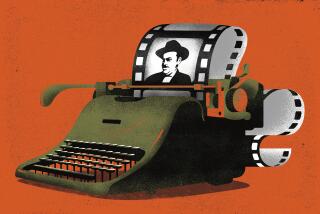In Hollywood, Welles Seems to Be Having the Last Laugh
- Share via
Considering how Hollywood abandoned him during his lifetime, Orson Welles would be amused by the flurry of activity to make some of his unproduced projects. In fact, his posthumous marketability has all the irony of a Welles film. Once again, time has caught up with the maverick.
Besides “The Big Brass Ring,” there is “The Cradle Will Rock,” Tim Robbins’ upcoming film chronicling Welles’ tumultuous staging of a pro-labor play in 1937, and “The Way to Santiago,” a mystery inspired by an obscure Welles script about an American amnesiac caught up in a foreign revolution, currently in development at the revamped RKO Pictures.
Welles’ ill-fated attempts to bring “Brass Ring” and “Cradle” to the screen in the early 1980s were understandable. Although filmmaking friend Henry Jaglom introduced the legendary director to various baby moguls, they had no use for him.
“Santiago,” which Welles wrote for actress Dolores Del Rio in 1941 after “Citizen Kane,” was just too hot to handle for RKO--the same studio that released “Kane.” The plot involved Nazi spies in Mexico, and the Mexican government would have none of that.
Producer Debra Hill recently approached RKO about making an updated version of “Santiago” after discovering an AFI student film based on the script’s first act. “I was very intrigued by this black-and-white version of Welles’ movie,” Hill says. “It had such potential. You have this character who gets hit on the head and has no idea which side he’s on, and he’s in love with a beautiful woman who could be his ally or enemy.
“I sent it to RKO’s Producers’ Circle division, which is in the process of revitalizing their illustrious catalog. We looked at Welles’ script and his notes, and now we’re in the process of finding a writer and developing a concept with the right political hot spot. We want to be partners with Welles.”
“Cradle’s” story is tied in with the volatile political and social situation during the height of the Depression. President Franklin D. Roosevelt instituted the Works Progress Administration as a way of employing theatrical professionals, and Welles was enlisted by a radical composer named Marc Blitzstein to direct his “labor opera.”
While the 22-year-old Welles didn’t share Blitzstein’s revolutionary ideas, he liked him personally and mounted an ambitious Broadway extravaganza utilizing the support of the WPA’s Federal Theatre. At the last moment, however, the WPA panicked because of the play’s highly sensitive plot: the unionization of the steel industry.
The opening was postponed and the theater sealed. Rather than walk away, Welles revamped “Cradle” in a private theater. Blitzstein performed alone on stage with a piano and a spotlight, while the actors accompanied him as part of the audience to protect their Equity status.
As luck would have it, the controversy worked to their advantage, transforming “Cradle” into a political rally against government repression and artistic rebellion. It also hastened the demise of the Federal Theatre.
What most intrigued Welles about making the movie was revisiting his younger self, whom he described as a “total stranger” to biographer Barbara Leaming. Not surprisingly, his script is a romanticized account that emphasizes art over politics.
But Welles was adamant about finding an actor in his 20s to accurately convey his extremely youthful appearance. (In “Cradle,” though, he is portrayed by thirtysomething Angus MacFayden.) No doubt to create his own imprint, Robbins has fashioned an entirely new “Cradle,” about the clash of art and politics involving real characters including Nelson Rockefeller (John Cusack) and artist Diego Rivera (Ruben Blades).
With the Welles resurgence in full swing, who knows? Maybe we’ll get to see the director’s long-awaited unreleased Hollywood diatribe “The Other Side of the Wind” before too long.


